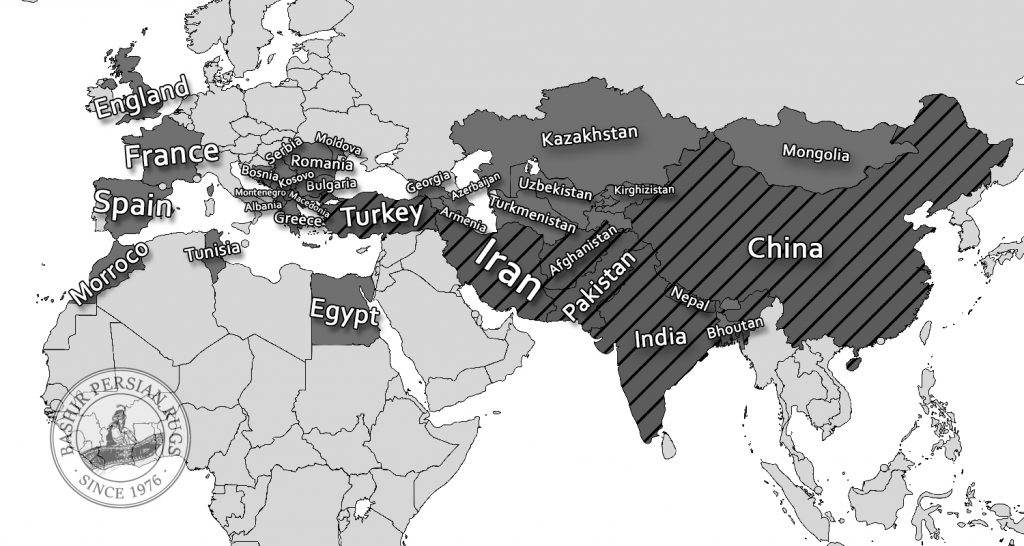I would like to address a question people often ask me about the naming of area rugs, Persian rugs, Oriental rugs and handmade carpets in general. In certain Canadian provinces, Persian & Oriental rugs are referred to as area rugs or small, Persian-style carpets. According to the Merriam-Webster dictionary, an area rug is defined as “a rug covering only part of the floor in a room”. I don’t know Merriam-Webster and I’m sure she doesn’t know me! There are some murky naming practices going around that lead to some confusion in the Persian carpet world.

Carpet Names
Once upon a time, the name of a carpet actually meant something. It usually corresponded to the town, village or tribe it was made in. Sometimes floral rugs are called Tabriz, Isfahan, Kashan or other titles matching the names of the Iranian cities they originated from. Today, the name of a rug just doesn’t mean as much as it used to. For example, ”Nain” would refer to a carpet made in the holy city of the same name in Iran.
Nowadays, a Tabas carpet, which is much cheaper than a Nain carpet but can closely resemble one, is sold as a ”Nain” because consumers will associate it with that level of quality. It may come from Iran and have a Nain design, but it is not the traditional Nain as we know it. This type of practice is so widespread that a majority of Internet retailers, stores and auction houses sell them as ”Nains”. It seems that if people like the color of the carpet, they are likely to buy it regardless.

In Arabic speaking countries, Persian and Oriental rugs and carpets are called “Sajjad e Ajami” which refers to all rugs and carpets that come from Persia or countries that were ruled by the former Persian empire during the Achaemenid Empire, which encompasses the entire territory of present day Iran, Afghanistan, Azerbaijan, Turkey, Armenia, Egypt and the Indian sub-continent, including the princely states in between, such as Kashmir. Up until the 1920s, floral rugs were referred to as Turkish carpets, since most Western carpet dealers were Armenian. These dealers stopped carrying Turkish carpets in the 1920s. At this point, they began importing and selling Persian carpets imported from modern day Persia and its surrounding areas, hence the widespread use of the term “Persian rugs”.
People often ask me: “What’s the difference between a rug and a carpet?” A larger size piece, such as one that is bigger than 8′ x 5′ is considered a carpet. Anything smaller than 8′ x 5′ feet is considered a rug. Often, in countries like Japan where rooms are smaller, they are called rugs.
Rug Producing Countries
Today, most handmade carpets come from countries located in Asia and Eastern Europe, such as:
- Afghanistan
- Pakistan
- Iran
- India
- China
- Nepal
- Turkey
- Turkmenistan
- Chechnya
- Azerbaijan
- Armenia
To learn more about rugs produced in these countries as well as many others such as France, England and Morocco, we invite you to visit our page on the history of hand-knotted rugs. In that section we cover in greater depth the rich history of handmade carpets from 15 different countries located in Europe, North Africa and Asia.

In 1984, the first embargo/sanctions on rugs and carpets imported from Iran into the U.S were introduced. It was lifted during the last year of the Clinton administration in 2001, only to be reinstated in 2005. American carpet dealers then started using the term “Oriental” rather than ”Persian” rugs and carpets, due to the fact that they started importing more carpets from other countries such as Pakistan, Turkey, India, China, etc. Thus, dealers started calling all Persian-style rugs “Oriental” rugs and the use of this term became prevalent. The term represents hand-knotted rugs with floral and geometric designs inspired from Eastern, Western and northern Iranian rugs.
Most Popular Rugs
Ten of the most sought after and popular handmade area rugs of the 21st century according to most industry experts and rug dealers are:
- Aubusson Rugs
- Bokhara Rugs
- Chobi Rugs
- Gabbeh Rugs
- Kazakh Rugs
- Kilim Rugs
- Oushak Rugs
- Overdyed Rugs
- Persian Medallion Rugs
- Quashqai Rugs
Area rugs truly give life to any room they are placed in. Oriental area rugs offer a lot of variation in terms of style and design, so you can be sure to find one to fit your room! They are of the finest quality and are built to last generations.



 Runner Rugs
Runner Rugs 2x3 Area Rugs
2x3 Area Rugs 3x5 Area Rugs
3x5 Area Rugs 4x6 Area Rugs
4x6 Area Rugs 5x7 Area Rugs
5x7 Area Rugs 6x9 Area Rugs
6x9 Area Rugs 8x10 Area Rugs
8x10 Area Rugs 9x12 Area Rugs
9x12 Area Rugs 10x14 Area Rugs
10x14 Area Rugs Round Rugs
Round Rugs Bath Mats
Bath Mats Doormats
Doormats 12x15 Area Rugs
12x15 Area Rugs

